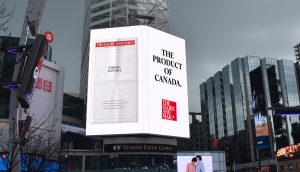In 2002, Charlie Crowe opened C Squared in London, UK, as a one-man consultancy to help media owners and agencies connect with their markets. Today it’s a specialist information company focusing on three business areas: contract publishing and events, training and consultancy, and the compilation of a creative media portfolio.
With Crowe as publisher, Cream Magazine launched in 2005 as a global digest of creative thinking in media planning and buying, with best case studies of media creativity, innovation and excellence from around the world. Crowe says the Canadian industry studies and scrutinizes the business more than other markets do, including the US. As a result, a disproportionate number – about 15% – of the 1,000 media case studies in the company’s CMDglobal.com database are from Canada.
Crowe will be in Toronto as both a speaker and panel moderator on March 27 at this year’s Canadian Media Directors Council Conference, ‘Pay Attention! New Forms of Engagement.’ MiC caught up with him to get his take on media innovation, engagement and the future of media agencies:
What do you consider innovative media?
We think a good media strategy has four elements – three reasonably tangible and one a little more difficult to quantify. The first is a tangible consumer insight revealing something to us about the way consumers are interacting with the media, or how consumers are changing.
The second is an insight into the brand, something that tells us a virtue that’s more than simply the quality of the product. At P&G many years ago, one of the insights was you could have a shampoo that didn’t just clean your hair, but nourished it. That sort of stretching of what the product was all about created a brand insight that made very good advertising.
Another good example is an ad for Daimler Chrysler for the Smart Car. The brand insight is not just that it’s easy to drive, but that it’s so easy to park in urban environments that you can park it nose-first in between other cars. Then the media created mini-sites literally parked in between other posters.
The third element is whether there’s an insight into the way people use the medium. It may be as simple as more people are reading newspapers on trains in the commute to work. So those are the three tangibles. Very rarely do we see examples with all three, but all good media innovations we (feature) in Cream Magazine have at least one of these elements. The fourth is fairly intangible. It’s just something that makes us smile.
What is your definition of engagement?
The word engagement is overused. But people confuse engagement with interactivity. They’re very different and I don’t think we’ve truly defined that difference. At the moment, interactivity is used as a proxy for engagement, so if you get more clickthroughs, or more people attending your event, that proves you’re somehow more engaged.
But engagement really goes deeper than a moment of interactivity. It’s something that will last, and ultimately something that’s more durable and therefore has value – increased sales, for example. Simply clicking through to a website, or responding to a digital TV screen, doesn’t necessarily mean you’re going to purchase a product or feel any warmer towards it. Agencies use interactive stats as proxies for stronger measures such as engagement or intent to purchase. That link is difficult to prove and depends on the product category and on the market, the medium being used at the time. What is truly engaging, I’m afraid the industry hasn’t really caught up with that yet.
How do you see agencies restructuring for the future?
From both the creative and media sides, it’s not an easy place to be at the moment because they’re having to change the way they deliver value for clients while also trying to work out how to protect their existing revenue streams. One impact of that has already happened, which is the increasing consolidation in the business. So WPP, Publicis, Interpublic and Omnicom as a collective group of the four holding companies now plan and buy about 70% of the world’s advertising.
Where will it go beyond that? We will see more examples of the holding companies becoming operating brands themselves and therefore able to pick and choose the different levels of service and companies they have within their operating groups. We’ve seen that a bit with HSBC appointing WPP to the global marketing task, where the CMO of HSBC could pick through WPP relationship operating companies within the group, whether it’s Mindshare for airtime buying, or JWT for creative.
So it’s not bundling back in the sense of a creative agency bringing the media agency back into the fold. It will be an innovation of big global advertisers picking the holding companies to service their accounts rather than operating companies. And I think that’s going to be more common in the industry over the next 12 months with more examples of the HSBC-style deal.
That will also be driven by branded content, oddly enough, because these big companies like WPP and Omnicom are creating entertainment divisions. More and more clients are looking for branded content, which requires the same cost efficiencies, the asset base, the financial leverage to create these deals and make them happen. So more advertisers are talking to the larger groups to make that happen throughout the network.
I think the degree of difference between the operating companies within the groups will lessen a little bit as the holding companies themselves become more important.

















